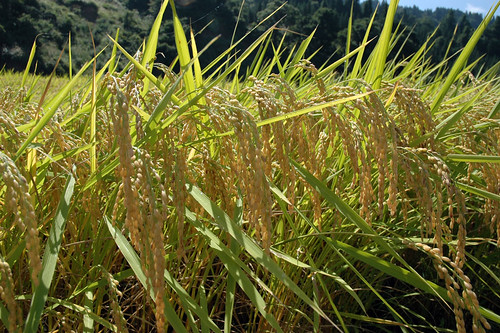
Mature rice, ready for harvest
Harvesting rice is a lot of work. I have a deep appreciation of each and every grain I eat now that I know what goes into just one day of rice production. The Yanagis, and thousands of other Japanese families, toil to feed me and I am grateful.
Sunday morning at 6:30 on the dot, Hanako, Tsuchiya-san and I sat down to breakfast prepared by our hostesses, who were awake and cooking at 5:30. At 8:30, we were called over to the Yanagi’s house to dress and wait for further instructions. The waiting made me fidgety and irritable. I wanted to go pick rice, but here were indoors with Kimie, who served tea and edamame and offered us our choice of hats and boots to wear outside.
By 9:30 we were finally in the field, where Akira Yanagi, his grandson, mother, neighbor and two young boys were already at work. After a quick demonstration of harvesting skills we’d need to use, we were set to work.
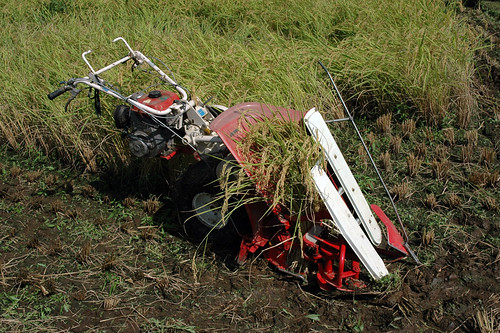
The machine harvester
Akira has a harvesting machine that growls like a lawnmower, and it’s not far off in size. The harvester is pushed by hand through the rows, cutting the clumps of rice near the ground and binding nine of them together with twine before spitting the bundle out to the side.
My first task was to follow the harvester, picking up the bundles it spit out and gathering them into sets of seven. I cinched them together with a noose-like rope, then carried the 10 kilo bundle to one corner of the field.
It was hot – around 33 C (91F) - the sky was clear blue and sun beat down on us. In a few minutes, I was sweating buckets and so was everyone else.
The harvester doesn’t get all the rice; uneven rows or a misdirected push can leave clumps uncut. So someone has to hand-cut the clumps. After a while, I followed the hand-harvesters around, picking up their clumps of nine and tying them into bundles using rice straw from the last harvest.
The technique was simple and effective – belt a few strands of straw around the bundle, twist once, and then spin the whole thing around itself to tighten the twist, and finally tuck the ends under the belt. I kept getting the thumb of my glove stuck in the twist when I spun the bundle, but a good sharp tug always freed it.
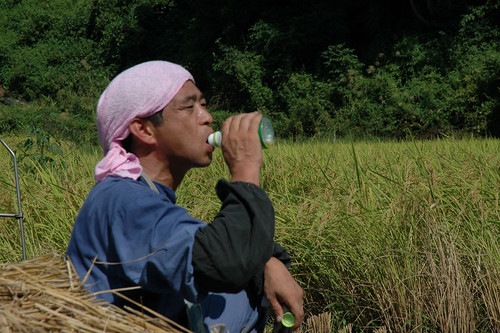
Enjoying a much-needed drink
It wasn’t long before we took a break and everyone had a small bottle of tea. Japanese don’t drink much compared to Americans. Maybe because their diet is saltier and they retain water so don’t need as much going in. I don’t know, but one 300 ml bottle of tea wasn’t enough for me but nobody else was having more, so I didn’t either. Very soon it was back to work.
More tying, spinning, cinching and carrying got us one field cleared. We moved the piled sheaves from the side of the field into the truck, laying the bundles rice-end in and alternating the direction of the layers so that the rice was secure and the grains protected for transportation.
Three men took the rice off to hang it up to dry in the sun while the rest of us started on the second field. This time, I asked to try the hand-cutting. With a short, serrated curved blade in one hand, you grasp the clump of rice in the other hand and draw the blade across in one firm movement. The trick is to make your cutting stroke count - not to saw at the rice – while not pulling the clump out of the soft muddy earth while you cut. It took me a while, but I did eventually get the hang of it. I was not adept, but I managed.
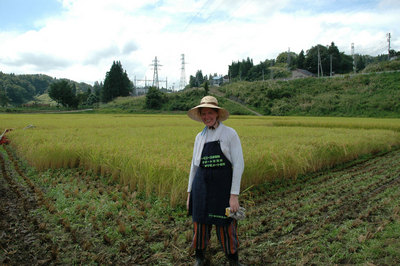
Farmer Kristen
I cut out part of a corner for the harvester to turn in and a whole row along one side of the paddy, and then took a break on my own– cutting the rice was more intense than bundling and carrying – and drank the last little bottle of tea. I noticed that the sky was starting to cloud up on the horizon. The weather forecast called for afternoon rain, followed by a few rainy days in a row, so we wanted to get as much rice in today as possible. My energy was starting to flag, but I was determined not to fall behind.
The truck was back, but now parked further away, so I loaded up the wheelbarrows with Hanako and we loaded the remainder of the first field into the truck. Then I did some more tying and carrying before a break was called for lunch. We put what we had completed in the truck, tidied up our tools and rode back to the Yanagi’s for lunch.
Everyone was covered in mud and sweat. “Ladies shower first!” one of the men called out and that meant, really, that “foreign ladies” shower first. So I stripped down, surprised at how very, very wet my clothes were, and hopped into the shower. Hanako called in to me, “Do you have a change of clothes for the afternoon?” Oops, no. I hadn’t considered that. Kimie kindly loaned me an entire outfit, including a brand-new pair of her panties. I looked like a grandmother in her largest polka dotted polyester ensemble, but I was dry.
While we were in the field, Kimie had prepared a feast of tempura vegetables, simmered fish and tofu, pickles and cold somen noodles. It was plentiful and bountiful and everyone at the table dug in like they’d never eaten before.
Only I wasn’t hungry. My head throbbed, my teeth ached and my stomach hurt. Hanako noticed my lack of appetite and asked if I was ok. I wasn’t sure. I had goosebumps and was feeling cold. I’d stopped sweating and I was hot to the touch. Hanako lead me upstairs and put me to bed under a quilt. I slept while they finished lunch.
When Hanako back came upstairs to change into her field clothes, she told me I would stay there while they went back out. I sat up, sipped some tea and declared that I was fine, really. “Mom, I want to go out to play!” I pleaded jokingly. But she insisted I rest. She was right, of course, but I was terribly disappointed as I listened to their laughing voices piling into the truck and driving away without me.
I drifted off to sleep again to be awakened half an hour later by the pounding of hard rain on the tin roof. “Rain! Ah…Rain? Ah!! The laundry!” I leapt up to rescue the clothes and towels hanging outside the second floor balconies. Kimie raced up after collecting everything downstairs and we put the glass doors on their tracks and rehung the clothes – only slightly damp - on plastic racks inside the house to finish drying.
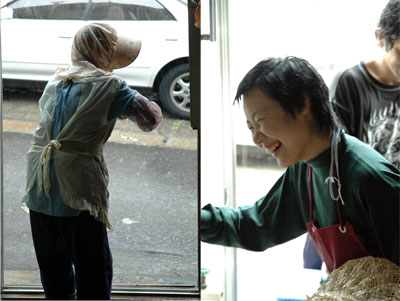
Kimiko wrings out her towel in the rain; Hanako laughs and drips into the house
That was the finish of the harvesting day, of course. Moments later the crew returned, soaked again but this time with rain. They were laughing and wringing out their clothes. We handed out all the towels and they changed – again – into clean dry togs.
Despite the heatstroke, I enjoyed the harvest immensely. I grinned like an idiot in the field, so happy to be joining in an aspect of life that is mostly hidden behind city supermarket price tags. And I hope this first harvest wasn’t my last.
(For more photos, see my Rice Harvest photo set on Flickr)
 My mother sent me an interesting package a few days ago, crammed with schoolwork, report cards and childhood art. Of course I dropped my work to page through everything and I was interested to see something on my report cards that I had never noticed.
My mother sent me an interesting package a few days ago, crammed with schoolwork, report cards and childhood art. Of course I dropped my work to page through everything and I was interested to see something on my report cards that I had never noticed.  Figs are in season now. I love the big dark figs we get here - beautifully pink and sweet on the inside, the skin is a little tart. Mmmmm. This recipe adds just the right extra touch, whiskey, to turn a fresh fig and a dollop of cheese into a light but luscious dessert. And it's only 81 calories - go ahead and make a double serving!
Figs are in season now. I love the big dark figs we get here - beautifully pink and sweet on the inside, the skin is a little tart. Mmmmm. This recipe adds just the right extra touch, whiskey, to turn a fresh fig and a dollop of cheese into a light but luscious dessert. And it's only 81 calories - go ahead and make a double serving!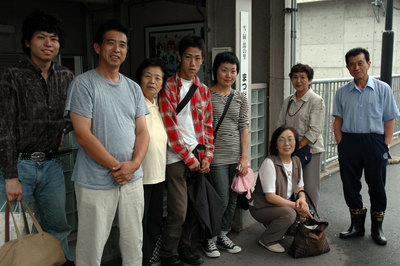





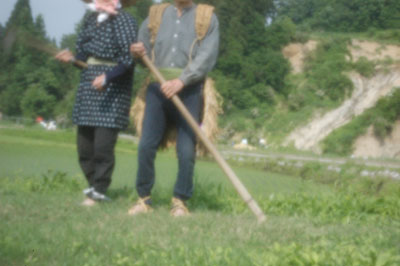

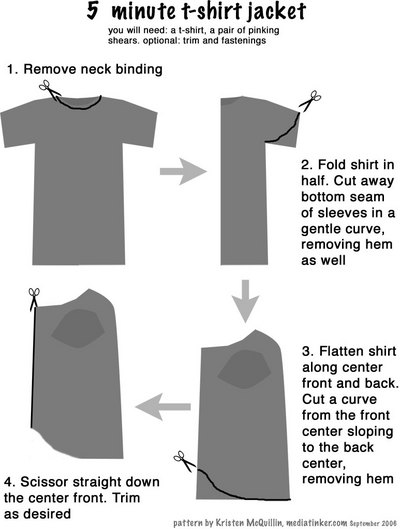

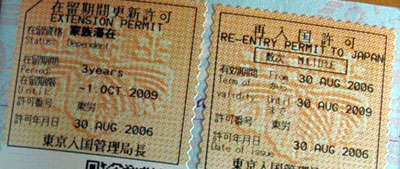

Recent Comments